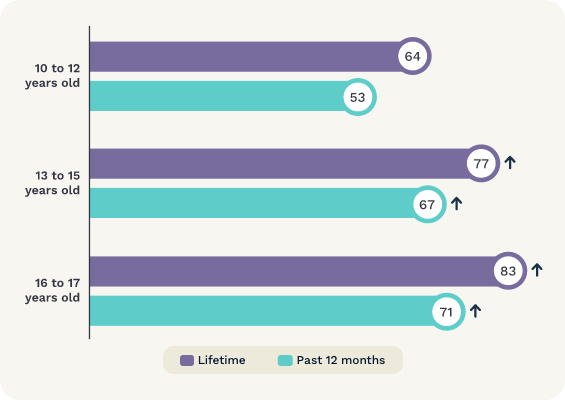How common is exposure to content associated with harm among children in Australia?
eSafety surveyed 3,454 Australian children aged 10 to 171 years to determine the prevalence of online experiences and harms, including exposure to content associated with harm.2
‘Content associated with harm’ includes such things as sexist, misogynistic or hateful content, content depicting dangerous online challenges or fight videos, or content that encourages unhealthy eating or exercise habits.
Key findings
We found that most children are exposed to content associated with harm online
Trans and gender-diverse children are more likely to be exposed to content associated with harm online
91%
of trans and gender-diverse children had seen or heard content associated with harm online.
(81% had seen or heard content associated with harm online in the past 12 months.)4
A similar proportion of girls and boys are exposed to content associated with harm online
More than 70%
of boys (74%) and girls (73%) had seen or heard content associated with harm online.
(62% of boys and 63% of girls had seen or heard content associated with harm online in the past 12 months.)
Exposure to content associated with harm increases with age5
Children are exposed to diverse forms of content associated with harm online
47%
had seen or heard offensive, sexist or hurtful things online about girls or women.
(37% in the past 12 months.)
47%
had seen fight videos posted online.
(34% in the past 12 months.)
46%
had seen dangerous online challenges.
(34% in the past 12 months.)
44%
had seen things online that encourage unhealthy eating or exercise habits.
(34% in the past 12 months.)
42%
had seen or heard offensive or threatening things about other people online because others are hateful of their identity.
(33% in the past 12 months.)
32%
had seen sexual images or videos online.
(23% in the past 12 months.)
27%
had seen things online that show or encourage illegal drug taking.
(20% in the past 12 months).
22%
had seen extreme real-life violence online.
(15% in the past 12 months.)
19%
had seen things online that suggest how a person can hurt or kill themselves on purpose.
(12% in the past 12 months.)
12%
had seen violent sexual images or videos online.
(8% in the past 12 months.)
26%
had seen or heard something else online that they found upsetting.
(18% in the past 12 months.)
Notes
1 Part of a nationally representative survey of 3,454 children aged 10 to 17 years living in Australia between December 2024 and February 2025.
2 For more information about the methodology of the research, see the methodology report.
3 Source: K.1.1 Have you ever seen or heard any of the following things online? You can include things that were said or posted as ‘just a joke’. Important: Please don’t include things you’ve seen in TV shows or movies, like on Netflix or Disney+.
4 The smaller sample size for trans and gender-diverse children should be considered when interpreting these findings (n=83).
5 Arrows denote statistically significant difference between sub-groups.
Helpful resources
eSafety’s Parents section has information for parents and carers, including information and advice about helping children stay safe online.
eSafety’s Kids and Young People sections provide useful information to help children and teens stay safe online.
Last updated: 22/07/2025
